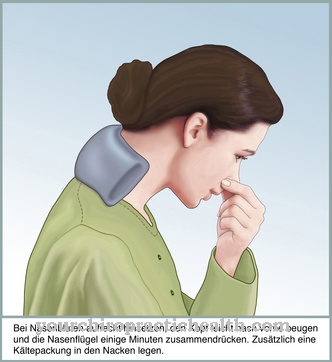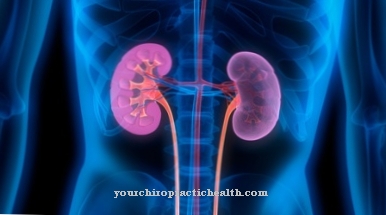Epistaxis is the colloquial term for the medical term Epistaxis. In most cases, nosebleeds are not dangerous. However, bleeding from the nose can also be life-threatening and difficult to treat. Dangerous bleeding often originates from the back of the nose.
causes

The causes of nosebleeds are different. There are localized nosebleeds and epistaxis as a symptom of a general illness. In around 80% of cases there is bleeding from vessels in the anterior area of the nasal septum. Blood vessels emerge from the depths of the nasal septum to the surface. They are particularly sensitive and vulnerable as they progress close to the surface of the mucous membrane.
Curvatures on the nasal septum also promote bleeding in this area due to curvatures. This can lead to increased turbulence in the breathing air, which can then lead to drying out and crusting of the mucous membrane.
The cause of nosebleeds is less common in the back and top of the nose or in the paranasal sinuses. Furthermore, illnesses such as high blood pressure or blood clotting disorders increase the risk of developing nosebleeds.
You can find your medication here
➔ Medicines for nosebleedsDiseases with this symptom
- flu
- Vitamin C deficiency
- arteriosclerosis
- Willebrand-Juergens Syndrome
- high blood pressure
- Osler's disease
- measles
- typhus
- Curvature of the nasal septum
- Nasal polyps
- Vitamin K deficiency
- Henoch-Schönlein purpura
- Eosinophilic granulomatosis with polyangiitis
- Arterial hypertension
- Broken nose
- scurvy
- Bleeding disorder
- hemophilia
Local nosebleed
Local nosebleeds are common in young children. It is usually not dangerous and quickly disappears on its own. It is mostly caused by personal injuries (e.g. excessive nose picking) or external injuries while playing.
Especially when playing, children often injure their head and nose through small scuffles. Furthermore, children often ingested nasal foreign bodies through direct contact with sand and earth, which can lead to nosebleeds through further friction and irritation.
However, allergies, dehydration of the nasal mucous membranes (e.g. from air conditioning) and runny nose (acute rhinitis) can lead to nosebleeds.
Epistaxis as a symptom of illness
Home remedies ↵ for nosebleeds Nosebleeds can occur as a symptom of infectious diseases such as flu, typhoid, or measles. Furthermore also through vascular and circulatory diseases such as arterial hypertension and arteriosclerosis. Blood thinners are also a common cause of nosebleeds. Nosebleeds due to a vitamin C deficiency (scurvy), pregnancy and hormonal changes are less common.
Diagnosis & course
If blood (light, dark, clumped) comes out of the nose, the doctor can use various methods to diagnose the cause. He can do a nasoscopy to determine the exact location of the bleeding.
X-rays of the head are another way of detecting or eliminating injuries caused by blunt blows or the like. Blood tests are also possible.
Nosebleeds usually come on suddenly. It is possible, however, that the nose bleed is unintentionally initiated by vigorous nose cleaning or nosing. With countermeasures (cold in the neck) the intensity can be weakened and stopped so that the nosebleed usually does not last long.
Diseases
- high blood pressure
- leukemia
Complications
Nosebleeds are mostly harmless and will go away on their own after a short time. However, if the nosebleed persists for a long time, it can lead to anemia. This occurs through blood loss and leads to tiredness, deficiency symptoms and other complications. The anemia can also lead to poor circulation with other symptoms such as chills and dizziness.
If you lose consciousness, there is a risk of blood entering the airways or esophagus. Blood in the windpipe can cause pneumonia or respiratory failure, while blood in the esophagus enters the stomach, often causing nausea and vomiting. There is a risk of bleeding to death if you have an arterial nosebleed. In addition, home remedies can lead to complications.
Tilting the head back, for example, can cause blood to enter the airways, while cooling the forehead and nose often increases the bleeding. Depending on the underlying disease, nosebleeds can cause other symptoms that require independent treatment. During therapy, the prescribed medication can lead to allergic reactions, but nosebleeds are usually treated by a specialist without any further complications.
When should you go to the doctor?
Epistaxis is not a concern to a healthy person. If the nosebleed cannot be stopped after 20 minutes, the result is excessive blood loss. In this case, it is recommended to consult a doctor. If the nose is noticeably bleeding, is pregnant or is frail, a doctor should be consulted after five to ten minutes.
If arterial bleeding occurs in the upper part of the nose, immediate medical treatment is necessary. The bleeding runs down the throat.
Often the nose bleeds after falls. If there is a visible injury, it is advisable to go to a hospital for clarification and treatment.
If light-colored fluid escapes from the nose after a skull injury, it may be cerebral fluid. The immediate notification of an emergency doctor is essential!
If you have frequent nosebleeds, it is advisable to make an appointment with your doctor. Your family doctor can carry out an initial assessment (blood pressure control). As special instruments are required for further examinations, it makes sense to go to the ENT doctor.
Doctors & therapists in your area
Treatment & Therapy
First of all, diseases like high blood pressure and bleeding disorders must be the cause Epistaxis be excluded. Medicines can also have an effect on blood clotting in the nose. Tumors of the nose and paranasal sinuses as well as vascular diseases should also be excluded before treatment.
Acute nosebleeds should first be stopped by tilting the head forward to avoid swallowing the blood. Placing a damp, cold washcloth on the neck narrows the blood vessels and the bleeding usually stops by itself.
If you have severe nosebleeds or if the bleeding does not stop, you should consult a doctor immediately. For further medical treatment, electrical or chemical sclerosing of the bleeding source can be applied. If this procedure does not work either, a nasal tamponade is inserted to stop the bleeding. This should remain in the nose for about two to three days and is usually very uncomfortable for the patient.
Outlook & forecast
As a rule, the nosebleed is only a temporary symptom and does not necessarily need to be treated by a doctor. The nosebleed often stops after a few minutes and can easily be stopped with a handkerchief, for example. However, the person concerned should not lie on their back or lean their head back, as this will cause the blood to flow back again. This should be prevented.
If the nosebleed occurs after a blow on the nose or after an accident, a doctor must be consulted urgently. It could be that the nose is broken, which is often not noticed by patients. In the case of a broken nose, the nose can only be straightened correctly in the first few days after the break. In this case, a visit to the doctor is mandatory. Even if the nose was not directly affected in an accident, a doctor should also be consulted if there is a nosebleed.
Nosebleeds are relatively common in children. However, if it goes away after a few minutes, this symptom is not a problem. If the nosebleed persists, see a doctor. In this case, the nosebleed may indicate another serious illness that needs treatment by a doctor.
You can find your medication here
➔ Medicines for nosebleedsYou can do that yourself
The methods of self-help with a nosebleed depend heavily on the cause of the bleeding. Should the nosebleed occur after an accident or after a strong blow to the nose, it is advisable to see a doctor. Especially with other symptoms such as dizziness, pain in the nose or in the head, it can be a broken nose. In this case, the patient must act quickly so that the bones do not grow together crookedly.
Under no circumstances should the person lie on their back or lean their head back. That would only make the blood flow back. It is helpful to put a piece of handkerchief into your nostril to stop the bleeding. Usually, the nosebleed will stop after a few minutes and will not cause any further problems or complications.
Nosebleeds occur relatively often, especially in children, because they often pick their noses and their sinuses are not yet well developed. However, if the nosebleed occurs frequently and is not associated with specific activities, a doctor should be consulted. In this case, it may be a chronic problem that needs treatment.

.jpg)












.jpg)













